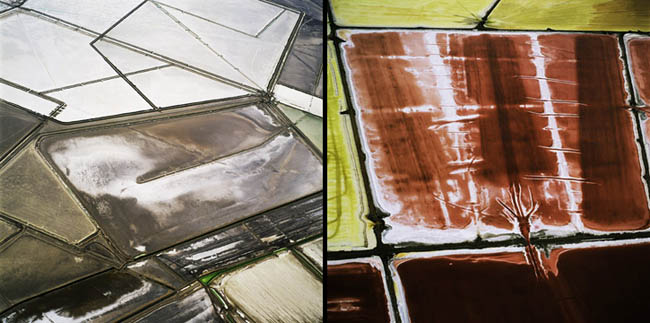Aerial Conversationalists
 [Image: Two landscapes photographed from above by David Maisel; from Terminal Mirage].
[Image: Two landscapes photographed from above by David Maisel; from Terminal Mirage].I'm excited to announce that I'll be participating in a roundtable discussion, on June 28, hosted by the Nevada Museum of Art in Reno.
Some long-term BLDGBLOG readers might remember that I interviewed photographer David Maisel about a year and a half ago for Archinect; well, David will be leading a guided tour of his photographs (at noon on June 28) at the Nevada Museum of Art, followed by a lecture about those images (at 7pm, the same day), by writer William L. Fox – ending, finally, with a roundtable discussion featuring Fox, Maisel, and myself.
The Nevada Museum of Art describes Fox as an author and independent scholar who "has spent three decades studying and writing about the ways in which humans understand where they are in landscapes, often focusing on art, mapping, and cognitive science." His many, many books include Driving to Mars: In the Arctic with NASA... and Terra Antarctica: Looking into the Emptiest Continent. He's also got a website.
Fox's work has come up many times on this blog; see this post, for instance, about high winds in Antarctica, carving musical instruments out of the rocks, or this post, in which huge underground spheres in the south polar glaciers are used as a new kind of cathedral, or even this post, in which settlers on Mars confront seemingly inescapable geo-simulations...
Finally, if you haven't read it yet, don't miss the Archinect interview with David Maisel.And I owe a huge thanks to the Nevada Museum of Art for inviting me up to participate in the first place.





Comments are moderated.
If it's not spam, it will appear here shortly!
In terms of landscape, I really recommend Pyramid Lake. It's to the east of Reno, but not that far.
Yeah, it looks great, actually: Pyramid Lake.
Thanks!
These photographs are awesome. They look like stained glass.
Havens-of-Manhattan.com
Geoff-
Discovered your great blog a while ago - glad to see you are doing well.
best
Adam B. Bell
Well even further to the east is the Dixie Valley Naval Bombing Range, a bombing range open to the public. The place is spectacular, you can see my photos on my Flckr photostream
you can also read much more at CLUI
Mount Shasta and Lassen Peak are spectacular massive volcanoes, and I have heard that the Lava Beds are really interesting. Most of the roads in the parks should be free of snow by now, but some of the trails in higher elevations could be snowed in still.
Shasta is unique because it is a 14,000+ foot peak that towers over a flat valley at about 2000-3000 feet. There is an article about it in the New York Times today.
I really did think this was a new line of tile! Please, someone remember me if you steal this idea...
Take US 395 up to Reno. See the infrastructure stealing your drinking water from the Owens valley. :-) Some of which is presented in 'Terminal Mirage.' Owens Valley was an ancient pluvial lake, too. White Mountains, Ancient Bristlecone Pines, megavolcano Mammoth area...
Have fun.
Hey, Adam Bell - what's going on? Good to hear from you.
Thanks for all the suggestions, meanwhile. I think we'll be heading north, toward Lassen and Lava Beds, but who knows. Thanks for the Mt. Shasta article, too... I'll see where our plans take us.
And I've seen Owens Lake, actually - we drove past it last year. A small amount of water is actually being left in the Owens Valley, but if the So. Cal. drought continues - a drought, incidentally, that is all but imperceptible on the ground right now - then we'll just drink the place dry... again.
I could be way off on this. Tom Robbins wrote a cool little short story about traveling in Nevada in his latest book (Wild Ducks Flying Backwards). The story talks about a place Tom calls the Canyon of the Vaginas, a mysterious cavern with numerous hieroglyphic odes to the yoni. A disclaimer: I have not confirmed whether or not this place is real or fake. But it seems to me that Tommy is just trying to a hide a really great landscape find. I followed some of his clues in the story and played around on Google Earth, but you can only see so much. You should go exploring if you're in the area and have the time.
Post a Comment